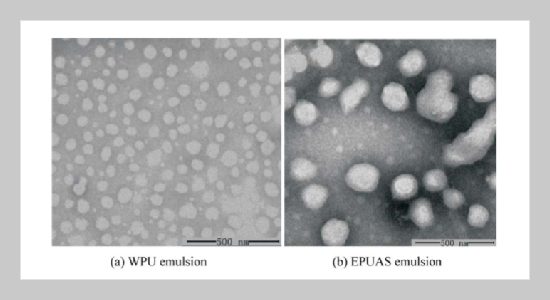REFERENCES
- [1] Li, X., Wang, X., Shen, Y., et al., “Synthesis and Characterization of Self-crosslinking Polyurethane/polyacrylate Composite Emulsion Based on Carbonyl-hydrazide reaction,” Journal of Polymer Research, Vol. 20, No. 11, pp. 19 (2013). doi: 10.1007/s10965-013- 0270-x
- [2] Cong, S. F. and Yu, L. R., Polyurethane Coatings, Beijing: Chemical Industy Press (2003).
- [3] Li, G. H., “Effect of Hydrophilic Monomer on the Surface Properties of Cationic Polyurethane-fluorinated Acryl Ate Hybrid Dispersions,” Journal of Applied Polymer Science, No. 99, pp. 27212725 (2006). doi: 10.1002/app.22450
- [4] Zhang, J., Li, X., Shi, X., et al., “Synthesis of Coreshell Acrylic Polyurehane Hybrid Latex as Binder of Aqueous Pigment Inks for Digital Inkjet Printing,” Progress in Natural Science, Vol. 22, No. 1, pp. 7178 (2012). doi: 10.1016/j.pnsc.2011.12.012
- [5] Bao, L. H., Lan, Y. J. and Zhang, S. F., “Study Vinyl Monomer Modified Castor Oil Waterborne Polyurethane,” Coatings Industry, Vol. 43, No. 2, pp. 4347 (2013).
- [6] Zhang, H., Shen, H. F., Zhang, X. Y., et al., “Influence of Polyurethane-acrylate Hybrid Emulsion Factors Performance,” Chemical Technology, Vol. 56, No. 9, pp. 17771782 (2006).
- [7] Mark, F. S., Steven, P. W., Benjamin, L., et al., “Poly(Acrylate/siloxane) Hybrid Adhesives for Polymers with Low Surface Energy,” International Journal of Adhesion & Adhesives, Vol. 28, No. 3 pp. 126 134 (2008). doi: 10.1016/j.ijadhadh.2007.07.001
- [8] Gong, M. N., Lai, X. J., Wang, R., et al., “Self-crosslinking Polyurethane-acrylic Hybrid Emulsion Preparation and Properties of Membranes,” Journal of Functional Materials, Vol. 46, No. 13, pp. 13079 13082 (2015).
- [9] Lu, T. F., Chen, S. and Li, X. Y., “Synthesis and Properties of GMA Modified UV-Curable Waterborne Polyurethane,” Paint & Coatings Industry, Vol. 40, No. 9, pp. 4652 (2010).
- [10] Dai, M. M., Preparation and Properties of Emulsifierfree St/BA Latexes in the Presence of Functional Monomers, Ph.D. Dissertation, Wuhan: Hubei University, Polymer Chemistry and Physics (2011).
- [11] Sardon, H., Irusta, L., Fernández-Berridi, M. J., et al. “Synthesis of Room Temperature Self-curable Waterborne Hybrid Polyurethanes Functionalized with (3- aminopropyl) Triethoxysilane (APTES),” Polymer, Vol. 51, No. 22, pp. 50515057 (2010). doi: 10.1016/j.poly mer.2010.08.035
- [12] Liu, X. J., Tu, X. H., Xu, X. X., et al., “Synthesis of High Solid Content Acid/sulfonate Waterborne Polyurethane Emulsion,” Paint & Coatings Industry, Vol. 43, No. 3, pp. 1724 (2013). (Chinese)
- [13] Wang, X. R., Shen, Y. D. and Lai, X. J., “Micromorphology and Mechanism of Polyurethane/polyacrylate Membranes Modified with Epoxide Group,” Progress in Organic Coatings, Vol. 77, No. 1, pp. 268276 (2014). doi: 10.1016/j.porgcoat.2013.09.013
- [14] Yue, J., Shen, Y. D., Lai, X. J. and Zhong, X. R., “Study on Properties of Crosslinked Anionic Waterborne Polyurethane,” Journal of Functional Materials, Vol. 42, No. 10, pp. 17951798 (2011). doi: 10.1007/ s10965-010-9438-9
- [15] Klimenkovs, I., Zhukovska, I., Uzulina, I., et al., “Maleic Diamide Polymerizable Surfactants, Applications in Emulsion Polymerization,” C.R. Chimie, Vol. 6, pp. 12951304 (2003). doi: 10.1016/j.crci.2003.07.015
- [16] Satyabrat, G. and Niranjan, K., “Biobased Biodegradable Waterborne Hyperbranched Polyurethane as an Ecofriendly Sustainable Material,” ACS Sustainable ChemEng, Vol. 2, No. 12, pp. 27302738 (2014). doi: 10.1021/sc5006022
















